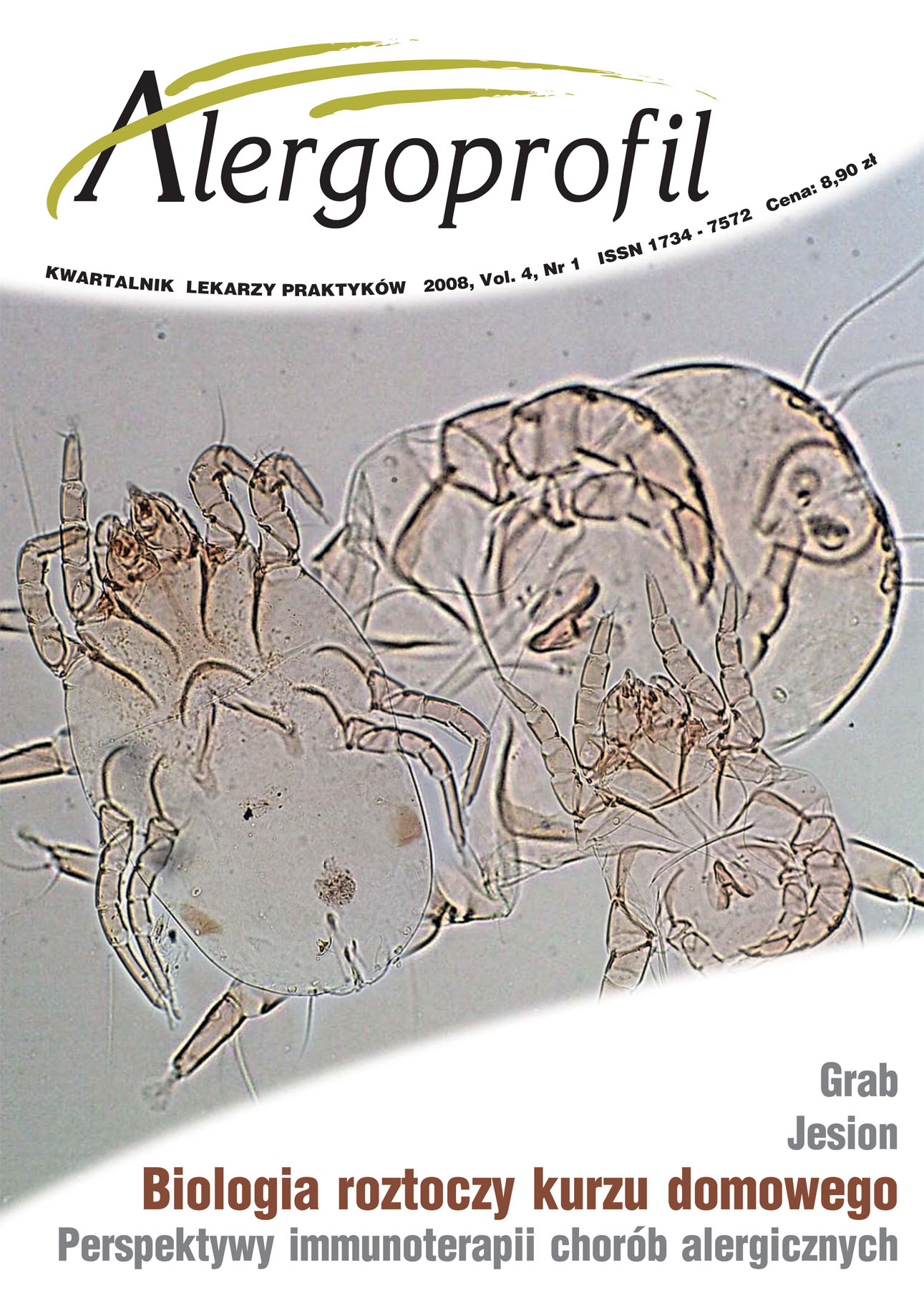The ash pollen allergens
Main Article Content
Abstract
Ash pollen season in Poland usually starts in April till the beginning of May depending on the region. Ash pollen count reaches moderate levels. The author presents current state of knowledge regarding ash pollen allergens and discuss their significance in allergic rhinitis among Polish people.
Downloads
Article Details
Copyright: © Medical Education sp. z o.o. This is an Open Access article distributed under the terms of the Attribution-NonCommercial 4.0 International (CC BY-NC 4.0). License (https://creativecommons.org/licenses/by-nc/4.0/), allowing third parties to copy and redistribute the material in any medium or format and to remix, transform, and build upon the material, provided the original work is properly cited and states its license.
Address reprint requests to: Medical Education, Marcin Kuźma (marcin.kuzma@mededu.pl)
References
2. Seneta W., Dolatowski J.: Dendrologia. PWN, Warszawa 2004.
3. Szczepanowicz B.: Atlas roślin biblijnych. Wyd. WAM, Kraków 2003.
4. Ziółkowska M.: Gawędy o drzewach. LSW, Warszawa 1983.
5. Dyakowska J.: Podręcznik palynologii. Metody i problemy. Wyd. Geologiczne, Warszawa 1959.
6. Puc M.: Pyłek wybranych taksonów roślin w powietrzu Szczecina, 2001–2005. W: Pyłek roślin w aeroplanktonie różnych regionów Polski.Weryszko-Chmielewska E. (red.). AM, Lublin 2006.
7. Chłopek K., Dąbrowska K.: Pyłek wybranych taksonów roślin w powietrzu Sosnowca, 2001–2005. W: Pyłek roślin w aeroplanktonie różnych regionów Polski.Weryszko-Chmielewska E. (red.). AM, Lublin 2006.
8. Malkiewicz M.: Pyłek wybranych taksonów roślin w powietrzu Wrocławia, 2003–2005. W: Pyłek roślin w aeroplanktonie różnych regionów Polski.Weryszko Chmielewska E. (red.). AM, Lublin 2006.
9. Rapiejko P.: Alergeny pyłku roślin. Medical Education, Warszawa 2008.
10. Weryszko-Chmielewska E., Piotrowska K.: Pyłek wybranych taksonów roślin w powietrzu Lublina w latach 2001-2005. W: Pyłek roślin w aeroplanktonie różnych regionów Polski.Weryszko-Chmielewska E. (red.). AM, Lublin 2006.
11. Hemmer W., Focke M., Wantke F., Gotz M., Jarisch R., Jager S., Gotz M.: Ash (Fraxinus excelsior) - pollen allergy in central Europe: specific role f pollen panallergens and the major allergen of ash pollen, Fra e 1. Allergy 2000, 55(10): 923-30.
12. Quiralte J., Florido F., Arias de Saavedra J.M., Gómez A., Sáenz de San Pedro B., González E., Rodríguez R.: Olive allergen-specific IgE responses in patients with Olea europaea pollinosis. Allergy. 2002, 57(supl.71): 47-52.
13. Florido J.F., Gonzalez P., Arias de Saavedra M., Quiralte J., Peralta V., Saenz de San P.: High levels of olive pollen and clinical findings. Int. Arch Allergy Immunol. 1999, 119: 133-7.
14. Quiralte J., Palacios L., Rodriguez R., Cardaba B., Arias de Saavedra J.M., Villalba M., Florido J.F., Lahoz C.: Modelling diseases: the allergens of Olea europaea pollen. J. Investig. Allergol. Clin. Immunol. 2007, 17(supl.1): 76-82.
15. Malo J.L., Cartier A.: Occupational asthma caused by exposure to ash wood dust (Fraxinus americana). Eur. Respir. J.1989, 2(4): 385-7.
16. Śpiewak R., Bozek A., Masłowski T., Brewczynski P.Z.: Occupational astma due to wood dust exposure (ash, oak, beech and pine) – a case study. Ann. Agric. Environ. Med. 1994, 1: 73-76.
17. Szmidt M., Gondorowicz K.: Bronchial asthma caused by exposure to Ash wood dust. Pol. Tyg. Lek. 1994, 49(14–15): 343-344

